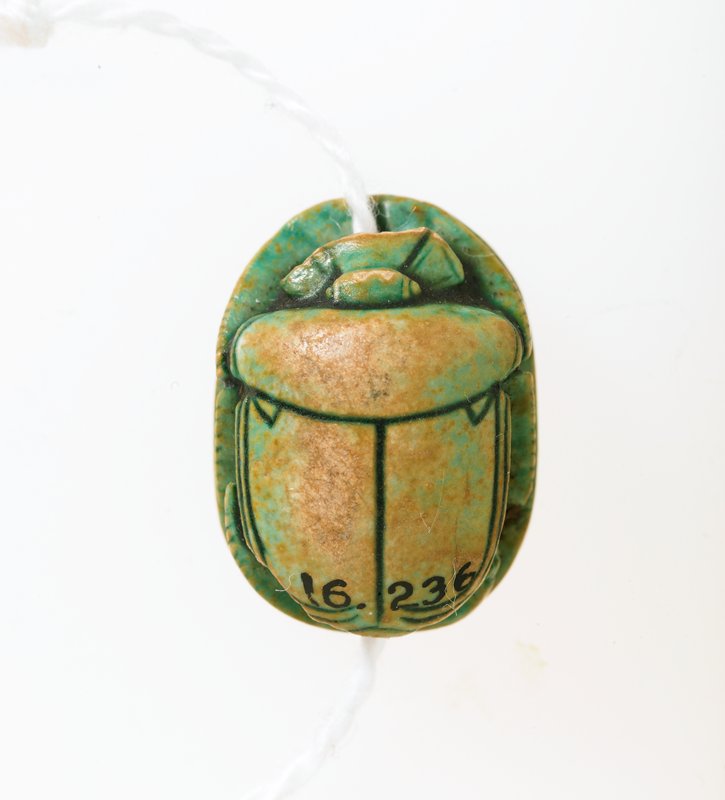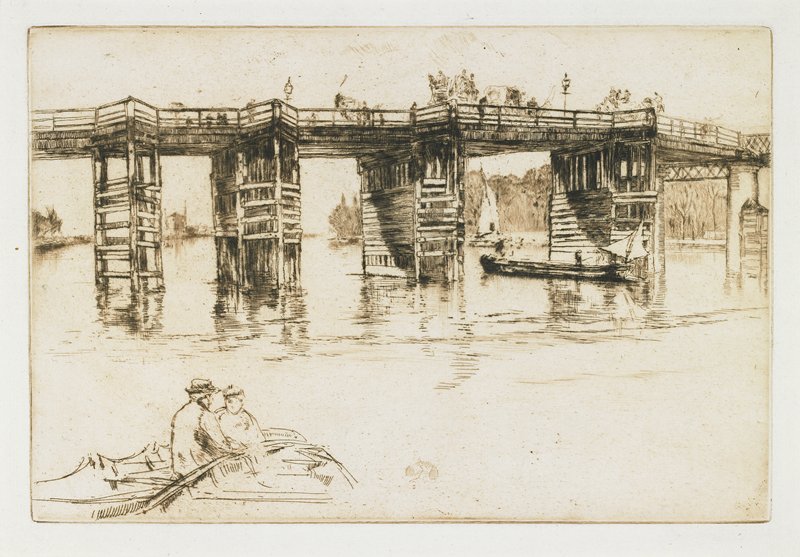The Art of Identification
Discover the different ways artists identify themselves on their works of art.
***
Fact #1: Signed and Sealed
In ancient times, stone cylinder seals were used to mark personal property and official documents, much as we use signatures and official stamps today. Often the owner's name and rank or occupation were carved on these seals, along with images of people, animals, and gods. This seal has two human figures, one riding a horse. The seal could be fastened to the owner's necklace or wristband by a cord or metal pin passed through a hole made lengthwise through the center.
The first cylinder seals were made about 5000 years ago in Mesopotamia (present-day Iraq). They were closely linked with the invention of an early form of writing on clay, called cuneiform (kyu-NEE-uh-form). As the influence of Mesopotamian culture spread, other civilizations began using cylinder seals.
In Mesopotamia and the surrounding region, most personal possessions were stored in jars or baskets. These were covered with a cloth secured with string, and a slab of clay was pressed over the string. The cylinder seal was rolled over the moist clay, leaving an imprint that identified the owner. Once the clay dried, anyone tampering with the contents would have to break the seal. Such seals were also used on warehouse doors and to verify accounting records.

Fact #1 caption/s
Rolled over wet clay, this cylinder seal leaves an imprint of two human figures, one on horseback.
This cylinder seal belonged to Ibni-sharrum, scribe to a Mesopotamian king. The inscription reads "divine Shar-kali-sharri, Ibni-sharrum the scribe is your servant."
Mesopotamia, late Akkadian period, reign of Shar-kali-sharri, Cylinder seal of Ibni-sharrum, c. 2217-2193 B.C., diorite, Musée du Louvre, Department of Near Eastern Antiquities, AO 22303. Photography B. White
Egyptians used signet seals in the shape of the sacred scarab beetle to identify owners and authenticate documents. Egypt, Scarab, 1504-1450 B.C., green-glazed steatite, Minneapolis Institute of Art, The William Hood Dunwoody Fund

****
Fact #2: Armed with an Identity
A coat of arms is a design, usually in a shield shape, that identifies an individual or a family. In medieval Europe, knights in armor going into battle or jousting in tournaments carried shields and banners displaying their coats of arms or other heraldic emblems. (Heraldry is the system of designing and assigning coats of arms.) These vivid symbols in bold colors helped soldiers tell friend from foe.
Coats of arms were granted by kings and queens to their knights and nobles. This Italian coat of arms belonged to the Borghese family of Rome. It can be traced to Cardinal Scipione Borghese, a great patron of the arts. This high-ranking churchman had one of the largest art collections in all of Europe, and his support helped the sculptor and architect Gian Lorenzo Bernini become 17th-century Italy's leader in the baroque style of art. The coat of arms has a crowned eagle above a dragon, three cherubs just above the shield, and, at the very top, the Borghese family's princely crown.
At first knights and nobles were free to chose their own symbols. But as more and more coats of arms were granted, and used as seals on legal documents as well as battlefield emblems, the imagery became strictly regulated. Today coats of arms are still used around the world for various purposes. But they are now granted to highly esteemed people whatever their social status.

Fact #2 caption/s
The Borghese eagle and dragon emblems appear on the inkwell in this painting of a Borghese family member.

This painting was made for an Italian church. The emblem of the Fiorenzi family in the lower left corner let worshipers know that it was paid for by Pier Filippo Fiorenzi, a church official.

****
Fact #3: Initial Impressions

Many artists sign their finished works with their full signature, but some use a design called a monogram, made from their initials. In a monogram, letters are combined in a unique way--often overlapping or intertwined--that identifies an artwork's maker.
The German artist Albrecht Dürer formed his initials A and D into the most famous of all artists' monograms. In the engraving Knight, Death, and the Devil, one of Dürer's best-known works, his monogram is in the lower left corner on a plaque, along with the year, 1513. Dürer always placed the monogram carefully within his compositions. He used it so successfully and it became so widely recognized that other German artists followed suit and started using monograms on their own artwork.
Dürer was the first great artist in Europe to work mainly as a printmaker rather than a painter or sculptor. His technical skill was unmatched, and artists across Europe copied his prints. The Italian printmaker Marcantonio Raimondi made replicas that even included Dürer's monogram. When Dürer found out, he went to Italy and took Marcantonio to court. Copying the images was judged legal, but reproducing the monogram was considered against the law.
Fact #3 caption/s
Dürer's famous monogram is made up of his initials A and D. Click here to see a print of Dürer’s coat of arms in the collection of the National Gallery of Victoria, Australia.
Imitation is said to be the most sincere form of flattery. Albrecht Altdorfer's monogram on this print is clearly an imitation of Dürer's.

****
Fact #4: All Sealed Up

Some famous Chinese paintings are almost covered in seals. Seals added by collectors and distinguished admirers are considered a mark of honor and add value to the art. Like the artist, these people took great care in the placement of their seals. The seals also help art historians trace the ownership of important paintings.
The plum branch in Wang Guxiang’s painting wraps around a poem about friendship. The three seals near the corners of the poem are the artist's. At the painting's lower left, the personal seal of the scholar and collector P'ang Yüan-chi states, “Examined and approved by Hsu-chai.” The two seals at the lower right are the artist’s and another of P’ang Yüan-chi’s, “Approved and collected by Lai-ch’en, a genuine work.”
Fact #4 caption/s
This is one of four different seals that the artist Wang Guxiang stamped on his painting.

This seal belonged to the painting's owner, Peng Nian .
****
Fact #5: Signed with a Symbol

The English painter Albert Joseph Moore belonged to a group of artists who believed in "art for art sake." They wanted to get away from social or moral themes and create art for the sole purpose of making something beautiful. The Aesthetic Movement, as it was called, was important in England and America in the 1860s and 1870s.
Moore was greatly influenced by ancient Greek art, especially some sculptures known as the Elgin Marbles. These masterpieces had been brought to England and put on display in the British Museum. Moore's admiration for their idealized human forms and natural poses can be seen in his painting Battledore (a battledore is a badminton racket). The woman's clothing is gathered and draped like the garments depicted by Greek sculptors.
Moore decided to sign his artwork with a fanlike flower shape called an anthemion (Greek for "flower")--a motif used in Greek art and architecture. In Battledore he placed the anthemion in the background. It fits in with other decorative designs so well that we almost don't realize we're seeing the artist's signature.

Fact #5 caption/s
This ancient Greek vessel has an anthemion band around the top. Attributed to the Painter of Vatican 359, Black-Figure Neck Amphora, c. 540 BCE, Slip-glazed earthenware, Minneapolis Institute of Art, The Ethel Morrison Van Derlip Fund
Moore's friend James McNeill Whistler also signed his works with a symbol, but his was inspired by Asian art. It began as a monogram and evolved into an abstract butterfly. James McNeill Whistler, Old Putney Bridge, 1879, etching and drypoint, Minneapolis Institute of Art, The William M. Ladd Collection, gift of Herschel V. Jones

![One of a pair of marriage portraits (see 57.10)
***
Related Activities
****
An Artist’s Mark
Artists' monograms often use letters to form unique yet recognizable designs. Design your own monogram for signing works of art that you create. Choose a letter or letters from your first, middle, and last names. Try different letter styles and play with the arrangement. Add your own touches to make your monogram distinctive.
Rolling It Out
With some clay and a dowel you can create your own cylinder seal. Begin by rolling the clay into a cylindrical shape. Press a small dowel through it lengthwise. This will make a hole so your seal can be strung onto a string. Use small pointed tools to carve a design and perhaps your name into the clay. You must carve your design in reverse; otherwise, the prints made with your seal will be backwards. Fire the clay in a kiln. Then roll it over a rectangle of fresh clay to see what the seal has to say.
An Eye for Advertising
Like the artists whose signatures are highlighted here, businesses and other organizations use designs that quickly convey their identity without the use of words. Such designs are called logos. Think of stores you visit or products you see on television that advertise with logos. List the names of these companies or products and draw their logos. What makes a logo successful? Why do you think logos are so widely used?